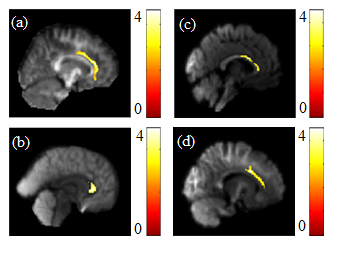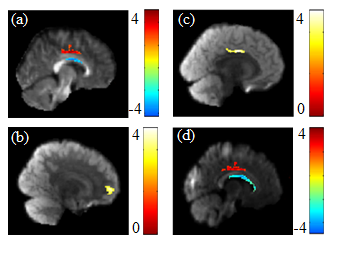1792
Relationships between brain structure and behavior in children with specific learning disabilities revealed by diffusion spectrum imaging1Department of Medical Imaging and Radiological Sciences, Chung Shan Medical University, Taichung, Taiwan, 2Department of Special Education, National Taiwan Normal University, Taipei, Taiwan, 3Department of Medical Imaging and Radiological Sciences, Chang Gung University, Taoyuan, Taiwan, 4Department of Psychiatry, Chang Gung Memorial Hospital, Chiayi, Taiwan
Synopsis
We used diffusion spectrum imaging (DSI) to investigate the relationships between brain structure and behavior in children with specific learning disabilities (SLD). The correlation between reading comprehension scores and the DSI indices was found in corpus callosum. The correlation between Chinese character recognition and the DSI indices was found in cingulate and corpus callosum. The correlation between tone awareness scores and the DSI indices was found in cingulate, superior frontal gyrus and corpus callosum. In summary, SLD not only had difficulty reading and spelling individual words but also more likely to have poorer phonological awareness.
Introduction
Specific learning disabilities (SLD) are mostly found in children affecting reading and writing, and the symptoms include difficulty reading or spelling individual words, the inability to focus when reading, and the inability to understand content that has been read. Previous studies have mostly detected the changes of the gray matter volume and shape 1. However, few studies have discussed the changes in the brain structures of SLD. Therefore, we tried to use diffusion spectrum imaging (DSI) to investigate the correlation between brain structures and clinical indices, including reading compression, Chinese character recognition and tone awareness.Methods
Diffusion images of 24 SLD and 22 age-matched healthy controls (HC) were obtained using DSI. All patients underwent a brain MRI examination on a 3T MRI system (Prisma, Siemens, Germany). The scanning parameters were as follows: repetition time = 6700 ms; echo time = 97 ms; 50 slices; 222 x 222 mm2 FOV; 2.7 mm slice thickness; 129 diffusion orientations sampled in the half q-space with b-values from 0 to 5000 s/mm2. The scan time for each patient was around 14 minutes.
Each participant’s original image was processed with Eddy Current Correction using FSL (FMRIB Software Library). The diffusion images were then spatially normalized to the Montreal Neurological Institute (MNI) T2W template using parameters determined from the normalization of the diffusion null image to the T2W template using Statistical Parametric Mapping (SPM). For the DSI analysis, DSI reconstruction was performed using DSI Studio, and the generalized fractional anisotropy (GFA), isotropic value of the orientation distribution function (ISO), and normalized quantitative anisotropy (NQA) mapping were calculated. For the statistical analysis, multiple regression was used to detect the correlation between the clinical and DSI indices for the 46 participants. Furthermore, sex and intelligence quotient (IQ), both of which were significantly different between groups, were used as covariates.
Results
In our study, a significant positive correlation between reading comprehension scores and GFA, NQA values and significant negative correlation between reading comprehension scores and ISO values were found in the corpus callosum (Fig. 1). A significant positive correlation between Chinese character recognition scores and GFA, NQA values were found in the corpus callosum and cingulate gyrus. A significant negative correlation between Chinese character recognition scores and ISO values in the corpus callosum was also found (Fig. 2). A significant positive correlation between tone awareness scores and GFA, NQA values in the cingulate gyrus was found, as was a significant negative correlation between tone awareness scores and GFA, NQA values in the corpus callous. A significant negative correlation between tone awareness scores and ISO values was found in the left superior frontal gyrus and cingulate gyrus (Fig. 3).Discussion
When the reading comprehension score was higher, in Fig. 1, the DSI indices in the corpus callosum were higher. The higher reading comprehension value for a person indicated that he/she has better reading comprehension ability, therefore efficient reading comprehension was dependent on the integrity of the fibers passing through corpus callosum 2. The corpus callosum was also believed to be related to reading comprehension and reading fluency 3. In Fig. 2, when the Chinese character recognition score was higher, the DSI indices in the corpus callosum and cingulate gyrus were higher. The higher Chinese character recognition score for a person indicated that he/she has better Chinese literacy. The corpus callosum may play an important role in the process of reading Chinese characters 4. Our previous study showed that the DSI indices of the cingulate gyrus were higher in the HC compared with the SLD. Therefore, we could conclude that SLD might have difficulty spelling individual words. In Fig. 3, when the tone awareness score was higher, the DSI indices in the cingulate gyrus and superior frontal gyrus were higher. The higher tone awareness score for a person indicated that he/she has better phonologic recognition ability. Tones were found to be related to activity in the cingulate gyrus 5. The involvement of the frontal cortex can explain problems related to language processing and phonemic awareness 6. The corpus callosum serves as a compensation mechanism in children with dyslexia 7. Our previous study showed that the DSI indices of the cingulate gyrus were higher in the HC compared with the SLD. Therefore, we could conclude that SLD might have poorer phonological awareness.Conclusion
Our results indicated that the SLD not only had difficulty reading and spelling individual words but also more likely to have poorer phonological awareness. Based on our results, we may have a better understanding in SLD and provide a potential target for the clinical treatment of SLD.Acknowledgements
This study was supported by the research programs NSC103-2420-H-003-008-MY3, which was sponsored by the Ministry of Science and Technology, Taipei, Taiwan.References
1. Vinckenbosch E, Robichon F and Eliez S. Gray matter alteration in dyslexia: converging evidence from volumetric and voxel-by-voxel MRI analyses. Neuropsychologia. 2005; 43: 324–331.
2. Welcome SE and Joanisse MF. Individual differences in white matter anatomy predict dissociable components of reading skill in adults. NeuroImage. 2014; 96: 261–275.
3. Edwards TJ, Sherr EH, Barkovich AJ, et al. Clinical, genetic and imaging findings identify new causes for corpus callosum development syndromes. Brain. 2014; 137: 1579–1613.
4. Daren Z, Lin C, Qifu T, et al. Naming asymmetry a Chinese case with staged callosal section. Acta Psychologica Sinica. 1991; 24: 63–69.
5. Alho K, Salmi J, Koistinen S, et al. Top-down controlled and bottom-up triggered orienting of auditory attention to pitch activate overlapping brain networks. Brain Research. 2015; 1626: 136-145.
6. Galaburda AM, Rosen GD, Denenberg VH, et al. Models of temporal processing and language development. Clinical Neuroscience Research. 2001; 1: 230-237.
7. Hasan KM, Molfese DL, Walimuni IS, et al. Diffusion tensor quantification and cognitive correlates of the macrostructure and microstructure of the corpus callosum in typically developing and dyslexic children. NMR Biomed. 2012; 25: 1263–1270.
Figures


